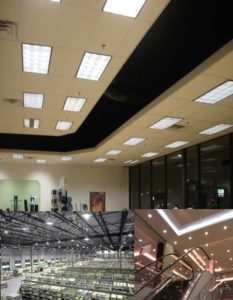Making big changes to an aging lighting system can produce big gains for a business, and for owners wondering how to reduce their electric bill, it’s a no brainer. Lighting is something that property owners tend to take for granted, but it shouldn’t be, because it is one of the principal sources of a business’s energy consumption. And the older the system, the more likely it is wasting power. With the rise of LED technology, there is a clear path to major energy savings, along with some other smart additions, like improved lighting controls.
How can a focus on lighting help reduce an electric bill?

- Focus on energy efficient lamps – In interior settings, a transition to CFL or LED lamps will offer the best gains in terms of efficiency, even over traditional fluorescent tubes. LED, for example, is about 20 percent more efficient than fluorescent tubes, and considering how many fixtures can be replaced at once, that’s a big boost in efficiency. The more attractive appearance of LED lamps is an added bonus.
In exterior applications, LED is also a smarter choice over traditional metal halides. LED lights are strongly directional, so they don’t require many reflectors to do their job. This saves on lumen output and drives efficiency further beyond metal halide lamps.
- Pair those lamps with smarter controls – In addition to their efficiency, LED lights also offer unmatched compatibility with lighting controls, giving property owners many options. For example, LED lights, both interior and exterior, can be readily dimmed to set levels at set times, allowing property owners to take full advantage of natural light and only spend money on the energy they need. LED lights can also be tied to occupancy sensors, both infrared and ultrasound, so they can be switched off automatically when there is no one nearby. That’s handy for occupants who typically forget to switch off the lights. Occupancy sensors are a major driver of energy efficiency. The Lighting Research Center found, on average, that companies that installed them saw an energy savings of 43 percent.
- Only get as much light as needed, and not a lumen more – Property owners often over-light their exterior spaces, including parking lots and walkways. With a comprehensive photometric analysis of the property, provided by an experienced lighting design professional, an installer can provide the exact fixtures required by the space, ensuring there is no waste following installation. This is ideal for an owner figuring out how to reduce their electric bill. Photometric analysis can also ensure even lighting throughout the property, enhancing security and aesthetics.
The running theme here is technology. By taking advantage of recent gains in lighting technology, a property owner can set their business up for major energy savings for years to come.






